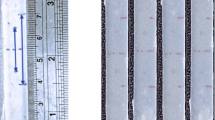Abstract
In general, laboratory tests render only a limited number of experimental data. Consequently, the prediction of material behaviour becomes a difficult task and, moreover, a statistical analysis with a statistically based approach is almost impossible. In order to increase the number of data, a method is introduced to generate artificial data by stochastic simulation. In this way, an arbitrary number of data is available and the process of parameter identification can be analysed statistically. The special challenge is the consideration of spatial problems with inhomogeneous stress/strain fields that are measured with an optical system and have to be fitted to a stochastic model in order to generate artificial data. B-Splines are applied to approximate the measured data in space and time. The aim of the study is an analysis of material parameters due to scattering of experimental data.























Similar content being viewed by others
References
Benjeddou A, Jankovich E, Hadhri T (1993) Determination of the parameters of Ogden’s law using biaxial data and Levenberg-Marquardt-Fletcher algorithm. J Elastom Plast 25(3):224–248
Box GE, Hunter WG, Hunter JS et al (1978) Statistics for experimenters. John Wiley & Sons, Hoboken
Box GE, Jenkins GM, Reinsel GC (2013) Time series analysis: forecasting and control. Wiley, San Francisco
Brockwell P, Davis R (2009) Time series: theory and methods. Springer, New York
Cottrell JA, Hughes TJ, Bazilevs Y (2009) Isogeometric analysis: toward integration of CAD and FEA. Wiley, Chichester
Harth T, Schwan S, Lehn J, Kollmann F (2004) Identification of material parameters for inelastic constitutive models: statistical analysis and design of experiments. Int J Plast 20(8–9):1403– 1440
Hartmann S, Tschöpe T, Schreiber L, Haupt P (2003) Finite deformations of a carbon black-filled rubber. experiment, optical measurement and material parameter identification using finite elements. Eur J Mech A 22(3):309–324
Hughes TJ, Cottrell JA, Bazilevs Y (2005) Isogeometric analysis: CAD, finite elements, NURBS, exact geometry and mesh refinement. Comput Methods Appl Mech Eng 194(39):4135–4195
Koch KR (2010) Three-dimensional nurbs surface estimated by lofting method. Int J Adv Manuf Technol 49(9–12):1059–1068
Kolonko M (2008) Stochastische simulation: grundlagen, algorithmen und anwendungen. Vieweg+Teubner Verlag, Wiesbaden
Krämer S, Rothe S, Hartmann S (2013) Homogeneous stress-strain states computed by 3D-stress algorithms of FE-codes: application to material parameter identification. Eng Comput 31(1):1–19
Kreißig R (1998) Auswertung inhomogener verschiebungsfelder zur Identifikation der parameter elastisch-plastischer deformationsgesetze. Forsch Ing 64(4–5):99–109
Kreißig R, Benedix U, Görke UJ (2001) Statistical aspects of the identification of material parameters for elasto-plastic models. Arch Appl Mech 71(2–3):123–134
Mahnken R (1998) Theoretische und numerische Aspekte zur Parameteridentifikation und modellierung bei metallischen werkstoffen. Dissertation, Inst. für Baumechanik und Numerische Mechanik
Mahnken R (2004) Identification of material parameters for constitutive equations. In: Stein E, de Borst R, Hughes TJR (eds) Encyclopedia of computational mechanics, vol 19. Wiley, New York, pp 637–655
Mahnken R, Stein E (1994) The identification of parameters for visco-plastic models via finite-element methods and gradient methods. Model Simul Mater Sci Eng 2(3A):597
Mahnken R, Stein E (1996) A unified approach for parameter identification of inelastic material models in the frame of the finite element method. Comput Methods Aappl Mech Eng 136(3):225–258
MATLAB (2012) version 8.0.0.783 (R2012b). The MathWorks Inc., Natick
GOM mbH (2007) Aramis Benutzerhandbuch-Software v6.1. GOM mbH
Nörenberg N, Mahnken R (2013) A stochastic model for parameter identification of adhesive materials. Arch Appl Mech 83:367– 378
Ogden R, Saccomandi G, Sgura I (2004) Fitting hyperelastic models to experimental data. Comput Mech 34(6):484–502
Ogden RW (1997) Non-linear elastic deformations. Courier Dover Publications, New York
Piegl LA, Tiller W (1997) The NURBS book. Springer, New York
Rogers DF (2001) An introduction to NURBS: with historical perspective. Morgan Kaufmann, San Francisco
Scheday G (2003) Theorie und Numerik der Parameteridentifikation von Materialmodellen der finiten elastizitt und inelastizitt auf grundlage optischer feldmessmethoden. Dissertation, Bericht Nr.: I-11, Institut fr Mechanik (Bauwesen), Lehrstuhl I, University of Stuttgart
Schlittgen R (2003) Einführung in die statistik. Wissenschaftsverlag, Oldenbourg
Schmaltz S, Willner K (2014) Comparison of different biaxial tests for the inverse identification of sheet steel material parameters. Strain 50(5):389–403
Schwan S (2000) Identifikation der parameter inelastischer werkstoffmodelle: statistische analyse und versuchsplanung. Dissertation, TU Darmstadt
Steel RGD, Torrie JH (1976) Introduction to statistics. McGraw-Hill series in probability and statistics, New York
Steinmann P, Betsch P, Stein E (1997) Fe plane stress analysis incorporating arbitrary 3d large strain constitutive models. Eng Comput 14(2):175–201
Twizell E, Ogden R (1983) Non-linear optimization of the material constants in ogden’s stress-deformation function for incompressinle isotropic elastic materials. J Australian Math Soc Ser B 24(04):424–434
Widany KU, Mahnken R (2012) Adaptivity for parameter identification of incompressible hyperelastic materials using stabilized tetrahedral elements. Comput Methods Appl Mech Eng 245:117–131
Acknowledgments
The financial support of this research by the German Research Foundation (DFG) under Grant MA 1979/16-1 is gratefully acknowledged.
Author information
Authors and Affiliations
Corresponding author
Rights and permissions
About this article
Cite this article
Nörenberg, N., Mahnken, R. Parameter identification for rubber materials with artificial spatially distributed data. Comput Mech 56, 353–370 (2015). https://doi.org/10.1007/s00466-015-1175-9
Received:
Accepted:
Published:
Issue Date:
DOI: https://doi.org/10.1007/s00466-015-1175-9




